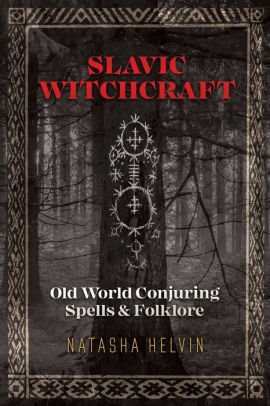Western European magical traditions were heavily suppressed by the Church. The introduction of Christianity into Russia, Ukraine and Belarus occurred much later and came up against staunch resistance. Eventually Eastern/Russian Orthodox Catholicism became merged with the local pagan traditions in a way that is roughly comparable to the merger of African traditions with Catholicism in the Caribbean.
Author Natasha Helvin starts her book with an overview of the way these two religious traditions came to exist side-by-side. The regional pagan pantheon took on the names and some of the characteristics of Catholic saints, and local magical practitioners continued to do their work without too much harassment from the Church. She uses the terms “sorcerer” and “sorceress” to describe the practitioners of magic in these areas. It was believed that a practitioner could transfer power to a recipient before death. Other practitioners were born with power. The way practitioners were regarded in these regions is discussed in depth. Pagan holy days were merged with Christian holy days and saint’s days as a form of appeasement (no list of these dates is included in the text, however).
The Eastern European traditions Helvin describes are highly idiosyncratic. The population had plenty of reasons to keep their magical traditions alive alongside the rigid limits of the Orthodox Church. It offered the people ways of resolving problems or changing situations unavailable through the religion.
Chapters 3 through 7 offer collections of spells addressing different concerns: love and relationships; wealth and business; protection; house and home; and health and healing. Most of the spells involve very simple chants and easily available materials. There’s a big range of useful procedures. The ethics of some of the spells veers toward the dark side in some cases. For instance, there are spells for stealing lovers, stealing luck and wealth, and for destroying people who have caused offense. There are a number of spells for removing and returning curses that are reminiscent of Voodoo procedures. Many of the spells are directions for making simple talismans (or mojo pouches) for luck, wealth, and protections.
Chapter 8 gives directions for spells for dream work and unusual types of divination. Chapter 9 is about cemetery traditions, superstitions, sorcery, and spells. Slavic traditions make use of power sites for fueling spell work, like cross-roads, ancient ruins and the like, but one of the focal power sites is cemeteries. Souls of the dead endure forty days of ups and downs before judgment is made, and the prayers, alms and good deeds of relatives on behalf of the deceased can influence the outcome. Burial traditions are covered, including procedures to prevent the deceased from wandering as a ghost. Slavic paganism incorporated ancestor worship and some of these traditions have survived to the present day. Rituals include thorough house-cleansing, special meals, and a lot of drinking. A community memorial celebration, Radonista, continues to be celebrated around Passover or after Orthodox Easter. Cemetery rituals include ways of detecting an active grave, required and prohibited actions the sorcerer must follow, and several spells specific to cemeteries. The final Chapter 10 gives “Simple Tips for All Occasions.” An index is included at the end of the book. The text includes photographs of people performing magical rituals.
This book offers unique insights into regional Slavic magical practices and superstitions that have remained mostly unchanged for centuries. It gives a singular insight into the region’s culture and its accommodation of Christianity over time. The book is nicely formatted and the material is well-organized and easily accessed. Recommended for those interested in studying regional traditions.
~review by Elizabeth Hazel
Author: Natasha Helvin
Destiny Books, 2019
pp. 224, 16.99
Slavic Witchcraft: Old World Conjuring, Spells and Folklore

©
2010 - 2025
Facing North
